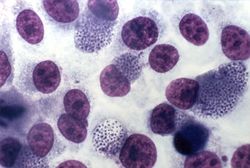Zoologists at the University of Basel in Switzerland have now
discovered a new parasite species that represents the missing link between
fungi and an extreme group of parasites.
Microsporidia are a large group of extreme parasites that invade
humans and animals and cost great damage for health care systems and in
agriculture; over 1,200 species are known. They live inside their host's cells
and have highly specialized features: They are only able to reproduce inside
the host's cells, they have the smallest known genome of all organisms with a
cell nucleus (eukaryotes) and they possess no mitochondria of their own (the
cell's power plant). In addition, they developed a specialized infection
apparatus, the polar tube, which they use to insert themselves into the cells
of their host. Due to their phenomenal high molecular evolution rate, genome
analysis has so far been rather unsuccessful: Their great genomic divergence
from all other known organisms further complicates the study of their
evolutionary lineage.
The team of zoologists lead by Prof. Dieter Ebert has been
studying the evolution of microsporidia for years. When they discovered a new
parasite in water fleas a couple of years ago, they classified this undescribed
species as a microsporidium, mostly because it possessed the unique
harpoon-like infection apparatus (the polar-tube), one of the hallmarks of
microsporidia. The analysis of the entire genome had several surprises in store
for them: The genome resembles more that of a fungi than a microsporidium and,
in addition, also has a mitochondrial genome. The new species, now named
Mitosporidium daphniae, thus represents the missing link between fungi and
microsporidia.
With the help of scientists in Sweden and the U.S., the Basel
researchers rewrote the evolutionary history of microsporidia. First, they
showed that the new species derives from the ancestors of all known
microsporidians and further, that the microsporidians derive from the most
ancient fungi; thus its exact place in the tree of life has finally been found.
Further research confirms that the new species does in fact have a
microsporidic, intracellular and parasitic lifestyle, but that its genome is
rather atypical for a microsporidium. It resembles much more the genome of
their fungal ancestors.
The scientists thus conclude that the microsporidia adopted
intracellular parasitism first and only later changed their genome
significantly. These genetic adaptations include the loss of mitochondria, as
well as extreme metabolic and genomic simplification.
For further details, see:



No comments:
Post a Comment
Pharmaceutical Microbiology Resources